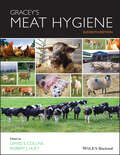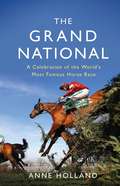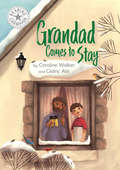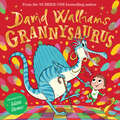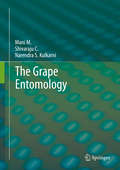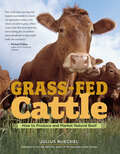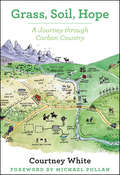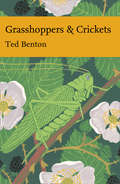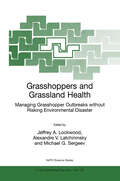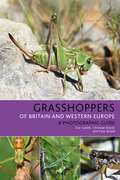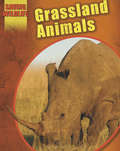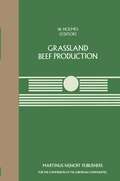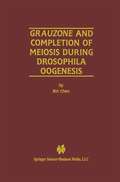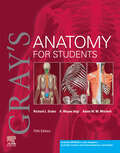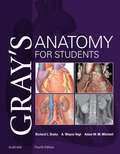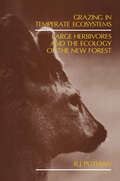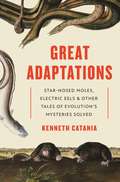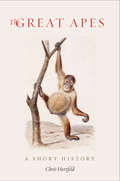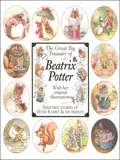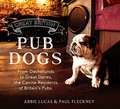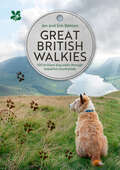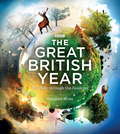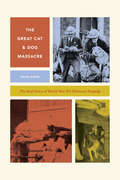- Table View
- List View
Gracey's Meat Hygiene
by David S. Collins Robert J. HueyGracey’s Meat Hygiene, Eleventh Edition is the definitive reference for veterinarians working in meat hygiene control. This new edition of a classic text reflects the recent significant changes in science, legislation and practical implementation of meat hygiene controls in the UK, Europe and worldwide since the 10th edition was published in 1999. An excellent practical guide for teaching food hygiene to veterinary students worldwide, in addition to laying the foundations of food animal anatomy, pathology and disease. New chapters address the increased concern of both the public and inspectors to issues of animal welfare and recognise the role of the profession, and interest from the consumer, in environmental protection. Key features include: Fully updated new edition, in a refreshed design with colour photographs and illustrations throughout. Includes new content on meat hygiene inspection covering the components of an integrated food safety management system as well as animal health and welfare controls in the ‘farm to fork’ system. A practical approach to health and safety in meat processing is outlined by identifying the hazards and then describing how these can best be controlled. With contributions from veterinary and industry experts, this edition is both a valuable teaching aid and a practical reference for veterinarians and all food business operators and their staff.
The Grand National: A Celebration of the World’s Most Famous Horse Race
by Anne HollandEvery year the Grand National produces very different stories from jockeys and horses alike; uplifting scenes from a victor and heartbreak when a mere inch divides the loser from the winner at the end of nearly four-and-a-half miles and 30 challenging fences. The race has evolved over the years but there is one constant: luck, or the lack of it. How fitting, then, that in 1839 the first winner was named Lottery. Back then, huge crowds rode to Aintree by horseback, in carriages, carts or on foot. Hotels were so full that some slept four guests to a bed. Today the Grand National is probably the world's most famous horse race, with a global television audience of some 600 million in 140 countries.Anne Holland's richly informed book focuses on the race's various record-breakers, rather than being a purely chronological history. In this greatest of all steeplechases, many records have stood the test of time. It is still jockey George Stevens from the 19th century who has ridden the most winners - five. In 2019, Tiger Roll's second consecutive victory was the first time that the feat had been achieved since Red Rum in 1973-74, and before that, Reynoldstown in 1935-36. Throughout its vivid history, many people have been opposed to the Grand National, claiming it to be dangerous. During the 21st century the famous fences have been modified, the drop at Becher's Brook reduced, and the landing levelled. All this has led to a laudable reduction in injuries.The Grand National continues to provide men, women and diverse thoroughbred horses with a true test of skill, bravery and perseverance. Anne Holland's authoritative history celebrates one of the world's greatest sporting spectacles.
Grandad Comes to Stay: Independent Reading White 10 (Reading Champion #501)
by Caroline WalkerOliver loves to RUN and he never sits still or moves slowly ... until an injury forces him to take it easy. Lucky for Oliver, Grandad comes round to help, and he is full of great ideas to have fun during Oliver's slow winter! This book is aimed at Independent Reading Book Band White 10, for readers aged from 5-7 years.This story is part of Reading Champion, a series carefully linked to book bands to encourage independent reading skills, developed with Dr Sue Bodman and Glen Franklin of UCL Institute of Education (IOE).Reading Champion offers independent reading books for children to practise and reinforce their developing reading skills.Fantastic, original stories are accompanied by engaging artwork and a reading activity. Each book has been carefully graded so that it can be matched to a child's reading ability, encouraging reading for pleasure.
Grannysaurus
by David WalliamsA boisterously funny new picture book from David Walliams and Adam Stower, perfect for young dinosaur fans!
Granulated Metrial Gland Cells (Advances in Anatomy, Embryology and Cell Biology #115)
by Sandra Peel1. 1 Historical Aspects and Terminology Granulated metrial gland (GMG) cells are readily identified by their cytoplasmic granules and were observed a number of years before the term "metrial gland" was introduced. A series of papers by Duval in 1891 provided a comprehensive description and a critical review of earlier studies of the placenta of rodents, but it was not until 1902 that the first convincing illustrations of GMG cells appeared in the literature (Jenkinson 1902). Jenkinson described "maternal glycogen cells" in the pregnant mouse uterus and noted that they contained cytoplasmic granules which stained with a variety of dyes. From his detailed description of the appearance and distribution of these maternal glycogen cells it is clear that he had observed what are now called granulated metrial gland cells. In 1911 Ancel and Bouin used the phrase une glande myometriale endocrine to describe a structure appearing between the muscle layers of the uterus at the insertion site of the placenta in rabbits. They described one of the cell types present in the glande myometriale as having the characteristics of glandular cells and noted their content of safraninophilic cytoplasmic granules. A glande myometriale endo crine was also described in the pregnant rat uterus by Weill (1919). He reported that the cellules granuleuses contained acidophilic inclusions and despite the absence of any illustrations in his paper it is apparent that he also had observed GMG cells.
The Grape Entomology
by M. Mani C. Shivaraju Narendra S. KulkarniIntensive and extensive cultivation of grapes (Vitis vinifera L.) leads to serious pest problem in vineyards in major grape growing areas of the world. Climatic conditions in India are favorable for high production of table and wine grapes, and thus also for incidence of variety of pests. These include the sucking insect pests namely thrips, hoppers, mealybugs etc., and beetle pests like stem borer, stem girdler, flea beetles, chafer beetles, shot hole borer and several lepidopteron, mites, nematodes and vertebrate pests. Pests of grapes in other countries relevant to Indian conditions are also dealt herewith since they may get introduced in India in future. Up to date information on biology, damage, seasonal development, management practices of the pests are covered in this book. Some of the pest management practices followed in other countries are also given, which will be useful to Indian conditions. Pesticide residue is a serious problem both for export and internal market in grapes. Guideline for pesticide residue management in grapes is also given in this book. The authors have tried to accommodate almost all the important information generated on the grape pests up to 2012. A complete list of grape pests (except disease) occurring in different grape growing regions of the world is also covered in this book which will be ready reckoner for the grape workers. The authors sincerely hope that this book will provide useful information to many entomologists, students working on grapes and the grape growers in the country. It is a pleasure to thank all those people who gave help, suggestions and encouragement in the preparation of our book “The Grape Entomology”.
Grass-Fed Cattle: How to Produce and Market Natural Beef
by Julius RuechelSuccessfully raise grass-fed cattle and enjoy the benefits of great-tasting beef and a financially stable enterprise. In this comprehensive guide, Julius Ruechel covers every aspect of raising healthy and thriving grass-fed cattle, offering advice on herd selection, pasture management, medical care, necessary equipment, winter grazing, slaughtering procedures, and more. With tips on creating a viable business plan and identifying niche markets for your beef, Ruechel provides everything you need to know to develop a profitable and environmentally sustainable grass-fed cattle operation.
Grass, Soil, Hope: A Journey Through Carbon Country
by Courtney White Michael PollanThis book tackles an increasingly crucial question: What can we do about the seemingly intractable challenges confronting all of humanity today, including climate change, global hunger, water scarcity, environmental stress, and economic instability? The quick answers are: Build topsoil. Fix creeks. Eat meat from pasture-raised animals. Scientists maintain that a mere 2 percent increase in the carbon content of the planet’s soils could offset 100 percent of all greenhouse gas emissions going into the atmosphere. But how could this be accomplished? What would it cost? Is it even possible? Yes, says author Courtney White, it is not only possible, but essential for the long-term health and sustainability of our environment and our economy. Right now, the only possibility of large-scale removal of greenhouse gases from the atmosphere is through plant photosynthesis and related land-based carbon sequestration activities. These include a range of already existing, low-tech, and proven practices: composting, no-till farming, climate-friendly livestock practices, conserving natural habitat, restoring degraded watersheds and rangelands, increasing biodiversity, and producing local food. In Grass, Soil, Hope, the author shows how all these practical strategies can be bundled together into an economic and ecological whole, with the aim of reducing atmospheric CO2 while producing substantial co-benefits for all living things. Soil is a huge natural sink for carbon dioxide. If we can draw increasing amounts carbon out of the atmosphere and store it safely in the soil then we can significantly address all the multiple challenges that now appear so intractable.
Grasshoppers and Crickets (Collins New Naturalist Library #120)
by Ted BentonFor the first time ever, a DVD featuring exclusive video and audio material accompanies the latest New Naturalist volume, a multimedia first for the series.
Grasshoppers and Grassland Health: Managing Grasshopper Outbreaks without Risking Environmental Disaster (NATO Science Partnership Subseries: 2 #73)
by Michael G. Sergeev Alexandre V. Latchininsky Jeffrey A. LockwoodAcridids (grasshoppers and locusts) can range from being rare curiosities to abundant menaces. Some are threatened with extinction and become subjects of intensive conservation efforts, while others are devastating pests and become the objects of massive control programmes. Even within a species, there are times when the animal is so abundant that its crushed masses cause the wheels of trains to skid (the Rocky Mountain grasshopper, Melanoplus spretus Walsh in western North America in the 1860s and I 870s), while at other times the animal is alarmingly scarce (the Rocky Mountain grasshopper went extinct in the early 1900s). Why are there these extremes in one insect family, and even in a single species? The NATO workshop examined this paradox and its implications for Environmental Security, which must address both the elements of land use (agricultural production and pest management) and conservation of biodiversity. The reconciliation of these objectives clearly demands a critical assessment of current knowledge and policies, identification of future research, and close working relationships among scientists. Insects can present two clear faces, as well as the intervening gradation. These extremes require us to respond in two ways: conservation of scarce species and suppression of abundant (harmful) species. But perhaps most important, these opposite poles also provide the opportunity for an exchange of information and insight.
Grasshoppers of Britain and Western Europe: A Photographic Guide
by Éric Sardet Christian Roesti Yoan BraudThis is the first guide to the 261 species of orthopterans – the grasshoppers, crickets and katydids – of Britain and western Europe ever published. Set out in a clear and accessible format and featuring a combination of photographs and illustrations, the book covers identification criteria of all of the main species and subspecies, with detailed photographs of males and females, distribution maps, status, habitat descriptions, oscillograms, advice on where and when to find them, and tips to avoid confusion during the often tricky process of identification. Comprehensive general chapters also cover morphology, ecology and habitat, and assist with research in the field. What makes this work the total package? The book comes with a CD, featuring 222 orthopteran songs. Together, book and CD make this the definitive guide to these insects and a rich resource for any naturalist in the region.
Grasshoppers of Britain and Western Europe: A Photographic Guide
by Éric Sardet Christian Roesti Yoan BraudThis is the first guide to the 261 species of orthopterans – the grasshoppers, crickets and katydids – of Britain and western Europe ever published. Set out in a clear and accessible format and featuring a combination of photographs and illustrations, the book covers identification criteria of all of the main species and subspecies, with detailed photographs of males and females, distribution maps, status, habitat descriptions, oscillograms, advice on where and when to find them, and tips to avoid confusion during the often tricky process of identification. Comprehensive general chapters also cover morphology, ecology and habitat, and assist with research in the field. What makes this work the total package? The book comes with a CD, featuring 222 orthopteran songs. Together, book and CD make this the definitive guide to these insects and a rich resource for any naturalist in the region.
Grassland Animals (Saving Wildlife)
by Sonya NewlandGrassland Animals looks at the effects of human habitation and hunting on creatures of the world's savannahs and prairies -- from the planet's greatest predators to insects in the grass.It is part of the Saving Wildlife series, which investigates the world's endangered species in the context of their different environments.
Grassland Beef Production: A Seminar in the CEC Programme of Coordination of Research on Beef Production, held at the Centre for European Agricultural Studies, Wye College (University of London), Ashford, Kent, UK, July 25–27, 1983 (Current Topics in Veterinary Medicine #28)
by W. HolmesGrauzone and Completion of Meiosis During Drosophila Oogenesis
by Bin ChenGrauzone and Completion of Meiosis During Drosophila Oogenesis describes the work behind a major, award winning discovery: the establishment of a new pathway that specifically regulates the female meiosis, a process essential for sexual reproduction. This book chronicles a new gene mapping method and the cloning and documentation of several types of genes that were proven to have significant influence on the cell cycle. It is of interest to anyone doing work with fruit flies, both graduate students and principal investigators.
Gray's Anatomy for Students E-Book: Gray's Anatomy for Students E-Book (Gray's Anatomy)
by Richard L. Drake A. Wayne Vogl Adam W.M. MitchellConcise, readable text and an outstanding art program make Gray's Anatomy for Students, 5th Edition, your go-to text for essential information in human anatomy. This fully revised volume focuses on the core information medical students need to know, in an easy-access format and with additional multimedia content to facilitate effective study and mastery of the material. A team of expert authors share a wealth of diverse teaching and clinical experience—all enhanced by more than 1,000 innovative, original illustrations by renowned illustrators Richard Tibbitts and Paul Richardson, who capture anatomical features with unrivalled clarity. Helps you understand the practical applications of anatomical concepts through unique coverage of surface anatomy, correlative diagnostic images, and clinical case studies. Contains increased representation of diverse population groups throughout, incorporating a wider range of skin tones and important clinical considerations related to transgender and intersex individuals. Presents anatomy logically by body region – as well as bonus updated eBook chapters for each major body system to facilitate learning from a different perspective. Includes new and improved online materials such as self-assessment questions, medical and physical therapy clinical cases, a unique Interactive Surface Anatomy tool, and more. Provides fully revised and updated clinical content including numerous new In the Clinic boxes, images, and correlates throughout that reflect the latest advances seen in clinical practice. New and updated Clinical Cases are included in the accompanying enhanced eBook. Features an updated neuroanatomy eBook chapter, so you can learn key aspects of this challenging topic in the context of general anatomy. Improves comprehension of complex cranial nerves with a visual map summarizing cranial nerve distribution and function. Offers schematic drawings for key structures and topics in every chapter, providing an additional, simplified approach to introduce each topic—ideal for quick initial understanding and as a guide for your own anatomy drawings. Enables you to quickly review the basic concepts from each chapter with Conceptual Overviews. Evolve Instructor site with a downloadable image bank is available to instructors through their Elsevier sales rep or via request at https://evolve.elsevier.com.
Gray's Anatomy for Students E-Book: With Student Consult Online Access (Gray's Anatomy Ser.)
by Richard Drake A. Wayne Vogl Adam W. MitchellEasy to read, superbly illustrated, and clinically relevant, Gray’s Anatomy for Students, 4th Edition, is medical students’ go-to text for essential information in human anatomy. This fully revised volume focuses on the core information students need to know, in an easy-access format and with additional multimedia tools that facilitate effective study and mastery of the material. A team of expert authors and global advisors share their extensive teaching and clinical experience, highlighted by more than 1,000 innovative, original illustrations throughout the text.Helps students understand the practical applications of anatomical concepts through unique coverage of surface anatomy, correlative diagnostic images, and clinical case studies. Presents anatomy logically by body region, and now offers bonus eBook chapters for each major body system to facilitate learning from a different perspective – covering the Cardiovascular System, Respiratory System, Gastrointestinal System, Urogenital System, Lymphatic System, and Nervous System.Features an all-new eBook chapter covering the essentials of neuroanatomy, so readers can learn key aspects of this challenging topic in the context of general anatomy.Offers new schematic drawings for key structures and topics in every chapter, providing an additional, simplified approach to introduce each topic—ideal for quick initial understanding and as a guide for students’ own anatomy drawings. Includes new and improved online materials such as self-assessment questions, clinical cases, an Interactive Surface Anatomy tool, an online anatomy and embryology self-study course, and more.Provides fully revised and updated clinical content including numerous new In the Clinic boxes, plus new clinical cases, images, and correlates throughout.Enables readers to quickly review the basic concepts from each chapter with Conceptual Overviews.Evolve Instructor site with a downloadable image bank is available to instructors through their Elsevier sales rep or via request at: https://evolve.elsevier.com
Grazing in Temperate Ecosystems: Large Herbivores and the Ecology of the New Forest
by R.J. PutmanThe New Forest in southern England is an area of mixed vegetation set aside as a Royal Hunting Forest in the eleventh century and since that time subjected to heavy grazing pressure from large herbivores. The entire structure of the Forest and its various communities has been developed under this continued history ofheavy grazing, with the estab lishment of a series of vegetational systems unique within the whole of Europe. The effects of large herbivores in the structuring of this eco system in the past, and the pressure of grazing continuing to this day, have in turn a profound influence, indeed the dominating influence, on the whole ecological functioning of the Forest system. Because of its assemblage of unique vegetation types, the area is clearly of tremendous ecological interest in its own right. In addition, its long history of heavy grazing ani the continued intense herbivore pressure make the New Forest an ideal study-site for evaluation of both short-term and long term effects of grazing upon temperate ecosystems. The N ew Forest (some 37,500 ha in total area) currently supports a population of approximately 2,500 wild deer (red, roe, sika and fallow); in addition 3,500 ponies and 2,000 domestic cattle are pastured on the Forest under Common Rights.
Great Adaptations: Star-Nosed Moles, Electric Eels, and Other Tales of Evolution’s Mysteries Solved
by Kenneth CataniaHow one scientist unlocked the secrets behind some of nature’s most astounding animalsFrom star-nosed moles that have super-sensing snouts to electric eels that paralyze their prey, animals possess unique and extraordinary abilities. In Great Adaptations, Kenneth Catania presents an entertaining and engaging look at some of nature’s most remarkable creatures. Telling the story of his biological detective work, Catania sheds light on the mysteries behind the behaviors of tentacled snakes, tiny shrews, zombie-making wasps, and more. He shows not only how studying these animals can provide deep insights into how life evolved, but also how scientific discovery can be filled with adventure and fun.Beginning with the star-nosed mole, Catania reveals what the creature’s nasal star is actually for, and what this tells us about how brains work. He explores how the deceptive hunting strategy of tentacled snakes leads prey straight to their mouths, how eels use electricity to control other animals, and why emerald jewel wasps make zombies out of cockroaches. He also solves the enigma of worm grunting—a traditional technique in which earthworms are enticed out of the ground—by teaming up with professional worm grunters. Catania demonstrates the merits of approaching science with an open mind, considers the role played by citizen scientists, and illustrates that most animals have incredible, hidden abilities that defy our imagination.Examining some strange and spectacular creatures, Great Adaptations offers a wondrous journey into nature’s grand designs.
The Great Apes: A Short History
by Chris HerzfeldA unique, beautifully illustrated exploration of our fascination with our closest primate relatives, and the development of primatology as a discipline This insightful work is a compact but wide-ranging survey of humankind’s relationship to the great apes (chimpanzees, bonobos, gorillas, orangutans), from antiquity to the present. Replete with fascinating historical details and anecdotes, it traces twists and turns in our construction of primate knowledge over five hundred years. Chris Herzfeld outlines the development of primatology and its key players and events, including well-known long-term field studies, notably the pioneering work by women such as Jane Goodall, Dian Fossey, and Biruté Galdikas. Herzfeld seeks to heighten our understanding of great apes and the many ways they are like us. The reader will encounter apes living in human families, painting apes, apes who use American Sign Language, and chimpanzees who travelled in space. A philosopher and historian specializing in primatology, Herzfeld offers thought-provoking insights about our perceptions of apes, as well as the boundary between “human” and “ape” and what it means to be either.
Great British Pub Dogs: From Dachshunds to Great Danes, the Canine Residents of Britain’s Pubs
by Abbie Lucas Paul Fleckney'Sheer, magnificent pointlessness' Marcus Berkmann, Spectator gift guideReader reviews: 'The perfect stocking filler for fans of our four-legged friends and great British pubs alike' - Richard Attwood'Bought one copy for myself and now I have come back another three times to buy it as presents for other people.' - Chris Moon'A perfect Christmas present!''Glorious photos and some very funny commentary''What an awesome collection of pub dogs''Beautiful pictures of a range of public house pooches the length and breadth of Britain' - Carl Morris'A beautifully crafted book giving a perfect insight into British culture' - Jill Monum'Great book, well thought out and beautifully produced'This beautifully photographed collection tells the stories of the much-loved dogs, of all kinds, that live in pubs all over Great Britain, not least the Pub Dog Capital of Britain, Whitstable. Locals love their pub dogs and landlords often say that people come in as much for the dog as for anything else. Dogs make a pub feel like home for regulars.Fleckney and Lucas chronicle the incredible variety of dogs that actually live in, rather than simply visit, Britain's pubs. They showcase the dogs with their beautiful photographic portraits and tell their stories, too. In feel, this is very much a 'family album' of British pub dogs.
Great British Walkies (National Trust)
by National Trust BooksDog-friendly country walks in Britain with places to eat and stay Supported by the National Trust, and includes their ‘pawprint rating’ system for dog-friendly places Breathtaking walks that aren’t too challenging – 2-6 miles in length. Suggested stops. Walks are created with dogs in mind – all the info you need. Don’t just take your dog for a walk. Take your dog for one of Britain’s 100 best dog walks. These country routes are custom-made for you and your four-legged friend. Ranging from 2 to 6 miles, they cover the whole of the UK and take some of our most beautiful woods, coast, rolling hills and fields, not to mention fascinating and inspiring historic sites. For each walk, there’s a map and comprehensive directions, plus information on whether and where a lead is needed and suggestions for dog-friendly refreshment stops and accommodation nearby.
The Great British Year: Wildlife through the Seasons
by Stephen MossBritain is a place of remarkable beauty and extraordinary extremes, boasting immense natural diversity in a comparatively small area. Here, life is run by the seasons: each month brings enormous transformations to our island and its inhabitants, from the largest native mammal to the smallest migrant bird. In this lavish companion to the unforgettable BBC One series, acclaimed nature writer Stephen Moss reveals a breathtaking view of the wildlife on our very own doorstep, complete with stunning photography, innovative maps and unique behind-the-scenes materialfrom the award-winning BBC Natural History Unit. Britain's wildlife is at once iconic and surprising, and this book celebrates it all in the light of our ever-changing seasons. From the clash of majestic stags to the emergence of delicate damselflies; and from the sharks and whales that swim our waters to the elegant and imposing birds in our skies, The Great British Year reveals the unmissable drama and beauty of our islands.
The Great Cat and Dog Massacre: The Real Story of World War Two's Unknown Tragedy (Animal Lives)
by Hilda KeanThe tragedies of World War II are well known. But at least one has been forgotten: in September 1939, four hundred thousand cats and dogs were massacred in Britain. The government, vets, and animal charities all advised against this killing. So why would thousands of British citizens line up to voluntarily euthanize household pets? In The Great Cat and Dog Massacre, Hilda Kean unearths the history, piecing together the compelling story of the life—and death—of Britain’s wartime animal companions. She explains that fear of imminent Nazi bombing and the desire to do something to prepare for war led Britons to sew blackout curtains, dig up flower beds for vegetable patches, send their children away to the countryside—and kill the family pet, in theory sparing them the suffering of a bombing raid. Kean’s narrative is gripping, unfolding through stories of shared experiences of bombing, food restrictions, sheltering, and mutual support. Soon pets became key to the war effort, providing emotional assistance and helping people to survive—a contribution for which the animals gained government recognition. Drawing extensively on new research from animal charities, state archives, diaries, and family stories, Kean does more than tell a virtually forgotten story. She complicates our understanding of World War II as a “good war” fought by a nation of “good” people. Accessibly written and generously illustrated, Kean’s account of this forgotten aspect of British history moves animals to center stage—forcing us to rethink our assumptions about ourselves and the animals with whom we share our homes.
